Beauty and the Beach
BY T. Travis Brown
While Wilmington is well-known for its azaleas Wrightsville Beach boasts a wide variety of its own special wildflowers. Surprised? Don’t be. Despite its beautiful but tough environment — poor soils dehydrating salt spray — there is a colorful world living amongst the meadows marshes and backyards that are protected by the dunes in coastal regions. Plants such as sea oats hold the dunes in place shielding their backsides from wind-blown salt spray. In these sheltered places plants like firewheel and yucca can safely grow. Behind our barrier islands lie the marshes where seashore mallow and marsh pink thrive in a mixture of salt and fresh water. Take another look. It’s not all sandy dunes and breaking waves; we live in an area with an abundance of beautiful and interesting plants.
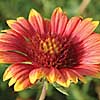 Firewheel
Firewheel
(Gaillardia pulchella)
Firewheel … what a perfect name for this flower. Just like the flames of a campfire the petals are dark orange at the base and yellow at the tips. Firewheel brightens roadsides dunes and other sandy areas along coastlines from Texas to Maryland. This flower is often called blanket flower and is closely related to the blanket flower (Gaillardia aristata) found mostly in the western U.S. Both species can be found at nurseries across the country and are particularly valued for their ability to bloom most of the summer with little water and in full sun.
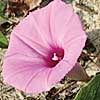 Coastal Morning Glory
Coastal Morning Glory
(Ipomoea cordatotriloba)
True to their name morning glory blooms open in the cool morning air of summer and then close at night. Coastal morning glory is another species growing along our coast that helps stabilize the dunes and beaches. A closely related species is the sweet potato (Ipomoea batatas) an American staple during Thanksgiving and year-round in many tropical countries. However many other morning glory species are noted for toxic and hallucinogenic properties when eaten. There are many wild and cultivated species of morning glory most of which are excellent for attracting hummingbirds and butterflies.
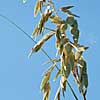 Sea Oats
Sea Oats
(Uniola paniculata)
You may be surprised to see this plant in an article about wildflowers but grasses actually are flowering plants. In fact sea oats may be one of the most important plants in Wrightsville Beach. While not endangered sea oats are legally protected in North Carolina and many other coastal regions for the vital role they play in protecting the fragile beach ecosystem. Their roots stabilize the dunes and guard the island from constantly being eroded. Sea oats actually have very small flowers in the early summer and spend the rest of the season showing off dangly seed heads that most of us recognize from along the beach. Their seeds provide food for many species of small mammals and birds and decomposing sea oat stems lend organic matter to the soil that allows species that aren’t as tolerant of poor sandy soils to grow.
 Clematis
Clematis
(Clematis species)
Late summer brings on a white cascade of flowers covering fences and shrubs across many yards. Some of these white mats of flowers are sweet autumn clematis (Clematis terniflora) an aggressive introduced vine from Asia. There are also similar species of native clematis such as virgin’s bower (Clematis virginiana) which grows in many habitats in our area and coastal virgin’s bower (Clematis catesbyana) which grows among the dunes. Sweet autumn clematis has flowers that are similar to native species of clematis but its leaves have smoother edges. Both wild and nursery varieties of clematis flowers attract butterflies and hummingbirds but planting invasive species like sweet autumn clematis should always be avoided.
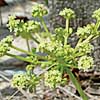 Dune Water Pennywort
Dune Water Pennywort
(Hydrocotyle bonariensis)
These round-leaved succulent little plants are common in wet swales along the coast. There are several species of pennywort or umbrella plant in North Carolina but all of them inhabit wetlands. Unlike some of the other flowers mentioned here this one can readily be found right in your backyard. It inhabits damp corners of most yards or other open areas and in fact some introduced exotic species can take over large areas and become extremely hard to eradicate. Hydrocotyle is a widespread genus and introduced species can come from South America Africa Asia and Australia.
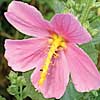 Seashore Mallow
Seashore Mallow
(Kosteletzkya virginica)
This is the brightest flower in the marsh. For most of the summer brilliant pink blossoms can be found on this 5- to 6-foot-tall plant. Seashore mallow is a plant of the upper marsh an area of low salinity that is flooded with saltwater infrequently or where saltwater and freshwater mix. However it can also be found in freshwater wetlands and is often grown as an ornamental. Seashore mallow is a member of the family Malvaceae which includes other notable members such as marsh mallow [seriously! (Althaea officinalis)] rose of Sharon (Hibiscus syriacus) and cotton (Gossypium hirsutum).
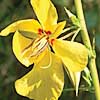 Partridge Pea
Partridge Pea
(Chamaecrista fasciculata)
A member of the legume family (Fabaceae) partridgepea is closely related to plants such as peas soybeans and clovers. Legumes have seeds that come in a small pod (called a legume). Legume family plants have the environmentally important ability to “fix” nitrogen. This means that bacteria living in small structures attached to the roots of legumes collect nitrogen (an important plant nutrient) from the air and impart it to the soil. In addition to trapping food for other plants partridgepea produces seeds that are an important food for many types of wildlife including birds and small mammals.
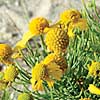 Bitterweed
Bitterweed
(Helenium amarum)
Also known as sneezeweed this beautiful little flower is common along roadsides and in disturbed areas throughout the southeast. It can be found growing right in the gravel of the road shoulder sometimes in the company of firewheel. The name of this plant comes from its bitter taste which is evidently imparted to the milk of any livestock that eat it. The bitter taste was even noted by Constantine Samuel Rafinesque — a prolific 19th century scholar who excelled in a wide variety of topics including botany proposing hundreds of new genera and thousands of new species in the major floristic regions of the world — who originally described bitterweed in 1817.
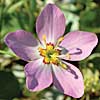 Marsh Pink
Marsh Pink
(Sabatia stellaris)
Though one of the rarer species marsh pink also known as rose of Plymouth can be found blooming much of the summer at the edge of the marsh or in wet meadows. Unlike many of our ornamental species of “pinks ” which are in the family Caryophyllaceae marsh pink is in the family Gentianaceae. This species has a light pink bloom with a yellow-orange star in the middle. Marsh pink can be found along the coastlines from Massachusetts to Mexico but is a rare occurrence in more northern states.
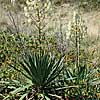 Yucca
Yucca
(Yucca species)
Yucca species belong to the same family as agave. Often called Spanish bayonet yucca species inhabit dry poor soils across the country. Two of the species that you are most likely to encounter along the North Carolina coast are curly-leaved yucca (Yucca filamentosa) and mound lily yucca (Yucca gloriosa). Yuccas are tough bristly plants but they do have several redeeming qualities: Leaves for instance (especially the partially rotten soft leaves at the bottom) can be twisted or braided into strong twine. The flowers are edible roots can be used to make soap and the dead stems are an excellent material for starting fire by friction.
There are many more plants that are adapted to the beach lifestyle living amongst poor soils and salty winds. If you would like to learn more about North Carolina plants then check out University of North Carolina plant identification resources at http://www.herbarium.unc.edu/. There are also many great books on southeastern plants available. Try these to get started: The Smithsonian Guide to Seaside Plants of the Gulf and Atlantic Coasts by Wilber and Marion Duncan A Guide to the Wildflowers of South Carolina by Richard Porcher and Douglas Rayner and Wild Flowers of North Carolina by William S. Justice and C. Ritchie Bell.
